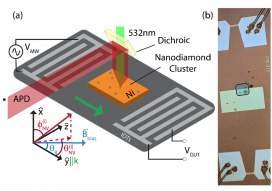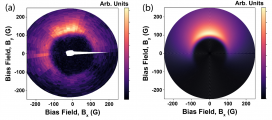Coupling Nitrogen Vacancy Centers to Magnetoelastic Waves
The nitrogen vacancy (NV) center is an atomic defect found in diamonds with the capability to store quantum information at room temperature and operate as a very low noise magnetic field sensor. These remarkable properties allow it to function as a probe of complex magnetic dynamics at high frequencies with atomic precision. By electromagnetically coupling NV centers to ferromagnetic thin films being driven by acoustic waves,researchers at the NSF-funded Engineering Research Center for Translational Applications of Nanoscale Multiferroic Systems (TANMS), headquartered at UCLA, demonstrated a linear interaction between these NV centers and the magnetic film and developed a model to explain key aspects of the interaction.
One major challenge facing NV centers is integration with traditional electronic manufacturing. Standard approaches to implementing NV center-based sensors involve high power consumption to produce the necessary electromagnetic fields coupling to the NV centers. TANMS’ approach offers a path to reducing this power consumption by orders of magnitude in a manner compatible with existing electronics manufacturing technology. This in turn has potential applications in a wide range of areas, including medical diagnostics, non-invasive brain-computer interfaces, and more.
TANMS researchers have characterized the interactions between NV centers and ferromagnets undergoing magnetic resonance excited by acoustic waves. They have identified a linear, potentially coherent coupling between NV centers and magnetoelastic waves with applicability for quantum sensing, and developed a model based on Maxwell’s equations matching the experimentally measured data. Furthermore, they have observed a second coupling mechanism present only when the magnetic film undergoes magnetic resonance, which indicates that the existing models of coupling may require revision.
The observed coupling occurs at remarkably low input microwave power relative to more traditional NV center drive sources, such as microwave stripline. Further, the fabricated device utilizes surface acoustic wave filter technology already present in commercial systems for signal processing. As a result, this magnetoelastic approach to communicating with NV centers holds great promise as a step toward practically applicable quantum sensing.



